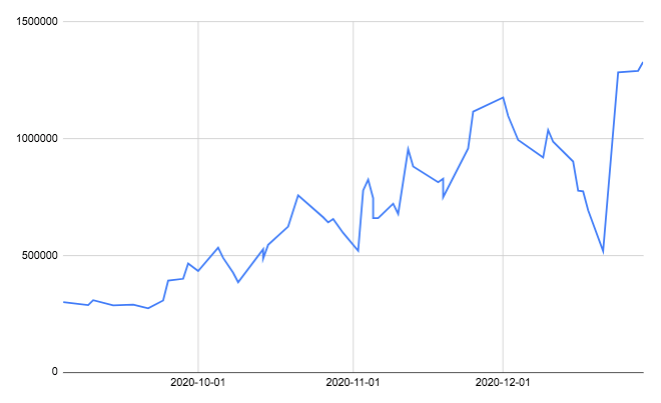
One of the systems I have been forward testing would have gone from 3 lakhs on September 1st 2020 to 13.4 lakhs by December end.
Needless to say, I was shocked and surprised.
Time for a thread 👇
Needless to say, I was shocked and surprised.
Time for a thread 👇

I have been forward testing a system on BankNifty for last four months.
I always forward test with 1 lot or the smallest size possible.
This is to make up for lack of clean data in the backtesting process.
I always forward test with 1 lot or the smallest size possible.
This is to make up for lack of clean data in the backtesting process.
I wanted to see what would have happened if I'd aggressively compounded the system.
I have been testing this with 2xATM option buying (for every 1x futures).
So, I took the results of the one lot test (after commissions and everything else is deducted) and applied it.
I have been testing this with 2xATM option buying (for every 1x futures).
So, I took the results of the one lot test (after commissions and everything else is deducted) and applied it.
Following are the rules:
1) Keep your system's historical maxDD amount as your per lot requirement.
2) Increase lot size with increase in profits.
3) When drawdowns happen, don't decrease lot size, keep the same size as the last equity high.
1) Keep your system's historical maxDD amount as your per lot requirement.
2) Increase lot size with increase in profits.
3) When drawdowns happen, don't decrease lot size, keep the same size as the last equity high.
So, when I tried looking at what my system's actual results would have converted to, had I used this kind of compounding:
- Started with 3 lakhs in September 1st week
- Ends with 13.4 lakhs by December last week.
What are we missing?
** THE CATCH **
55% max drawdown.
- Started with 3 lakhs in September 1st week
- Ends with 13.4 lakhs by December last week.
What are we missing?
** THE CATCH **
55% max drawdown.
I tested my system for this position sizing with monte carlo analysis.
Turns out there's a roughly 45% probability of risk of ruin if I'd compounded this way historically.
That's quite high.
So, while I could do something like this for a short time, in the long run, I can't.
Turns out there's a roughly 45% probability of risk of ruin if I'd compounded this way historically.
That's quite high.
So, while I could do something like this for a short time, in the long run, I can't.
In the long run, we definitely face risk of ruin with this method of compounding.
Ruin in my backtests for this type of compounding is if the system has a specific lot size and can't trade that size with the available cash.
That's the "stop trading" point.
Ruin in my backtests for this type of compounding is if the system has a specific lot size and can't trade that size with the available cash.
That's the "stop trading" point.
Would I be happy with 3 lakhs to 13 lakhs, but with 55% maxDD?
Sure. I bet.
But can I stomach the same if it happened like 3 crores to 13 crores, but with a 6 crores drawdown? Probably not.
Also, at 3 crores or so, the slippages will be more, so tighter execution needed.
Sure. I bet.
But can I stomach the same if it happened like 3 crores to 13 crores, but with a 6 crores drawdown? Probably not.
Also, at 3 crores or so, the slippages will be more, so tighter execution needed.
So, you'd be able to use such aggressive compounding for a small account, scaling it fast.
But even for a small account, you need a tightly tested system to be confident enough to trade through such big drawdowns.
I am sure no one starting with 3 lakhs can stomach 6 lakhs DD.
But even for a small account, you need a tightly tested system to be confident enough to trade through such big drawdowns.
I am sure no one starting with 3 lakhs can stomach 6 lakhs DD.
Especially if your account went to 11.7 lakhs, and then came down by 6 lakhs, it's not easy to accept, rather than if it slowly went from 3 lakhs to 5 lakhs.
That's where the confidence gained through thorough testing does its work. It lets you compound with confidence.
That's where the confidence gained through thorough testing does its work. It lets you compound with confidence.
@langvalcapital suggested a way to do this.
Start with 5 lakhs. Compound it and make another 5 lakhs out of it (take 1-2 years) following a proper system.
Take 3 lakhs out of those profits, and do aggressive compounding on that. See what you're able to do.
Start with 5 lakhs. Compound it and make another 5 lakhs out of it (take 1-2 years) following a proper system.
Take 3 lakhs out of those profits, and do aggressive compounding on that. See what you're able to do.
Don't attempt this with your entire capital. It's highly risky.
Also, if the maxDD period starts for your system immediately after you start trading, it will be very difficult to trade.
So, be mindful of the risk and the potential for ruin before you adopt this approach.
Also, if the maxDD period starts for your system immediately after you start trading, it will be very difficult to trade.
So, be mindful of the risk and the potential for ruin before you adopt this approach.
• • •
Missing some Tweet in this thread? You can try to
force a refresh


